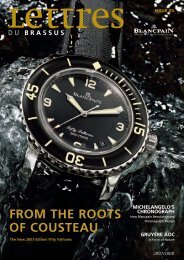IF ONLY WALLS COULD SPEAK - Blancpain
IF ONLY WALLS COULD SPEAK - Blancpain
IF ONLY WALLS COULD SPEAK - Blancpain
You also want an ePaper? Increase the reach of your titles
YUMPU automatically turns print PDFs into web optimized ePapers that Google loves.
ART DE VIVRE<br />
NO ONE PERSON FULLY MASTERS<br />
THE VEXING COMPLEXITY OF THE<br />
Winston Churchill, always one to turn a<br />
phrase, conjured the description “a<br />
mystery wrapped in an enigma”. He was not<br />
speaking of wine, but he easily could have<br />
been describing the world of French burgundy.<br />
No one person fully masters the vexing<br />
complexity of the burgundy region. Take for<br />
example the famous Grand Cru vineyard of<br />
Clos de Vougeot. There are nearly 100 different<br />
owners of separate parcels within this<br />
single vineyard, producing wine under different<br />
names, and, most importantly, no two of<br />
these wines, each bearing the same vineyard<br />
name, are exactly alike. To the diversity of production<br />
(each producer reflecting the style,<br />
approach and talent of the wine maker and<br />
caretaker of the vines) adds the year to year<br />
vintage variation, and one confronts an exceedingly<br />
complex matrix of wine quality and styles<br />
ranging from profound, ethereal, earthy to,<br />
BURGUNDY REGION.<br />
Mounir Saouma “Lucien Le Moine“<br />
sadly in a few cases, thin and mediocre. And<br />
this is the complexity reflected in just one of<br />
the dozens of vineyards that comprise the<br />
Côte de Nuits and Côte de Beaune.<br />
Finding great burgundy is a quest to unravel<br />
the complexities of the region and to latch<br />
onto producers dedicated to quality. Over the<br />
last 30 years, this quest increasingly has been<br />
a search for domain wines, that is, wines<br />
whose origins exist entirely under “one roof”,<br />
so to speak. These are wines where the owner<br />
of the vines, raises the vines, controls the harvest,<br />
conducts and controls the vinification<br />
and, then finally, bottles the finished wine. The<br />
emergence of such domain wines represented<br />
a remarkable revolution in burgundy.<br />
Previously the region had been dominated by<br />
large houses called “negotiants”, who purchased<br />
wine already in barrels, trusting in the<br />
raising of the vines (“élevage”) and vinifica-<br />
tion of others. The negotiants with their substantial<br />
commercial size performed a valuable<br />
service for small wine producers. They removed<br />
the distribution and sales burdens<br />
which many small producers felt unable to<br />
bear. With their purchases of much of the production<br />
of the entire region, the negotiants<br />
became the principle source of burgundy for<br />
the consumer.<br />
Unfortunately, the negotiant business<br />
model often did not result in wines of distinction.<br />
Their identity hidden and, by reason of<br />
often long-term purchase contracts, insulated<br />
from substantial commercial risk (or reward),<br />
the vintners who actually made the wine had<br />
reduced incentives to excel. Also contributing<br />
to mediocrity was a risk averse predilection of<br />
the negotiants. Many did not want wines that<br />
excelled. They wanted “safe” wines that<br />
could be easily sold. Finally, the negotiants







